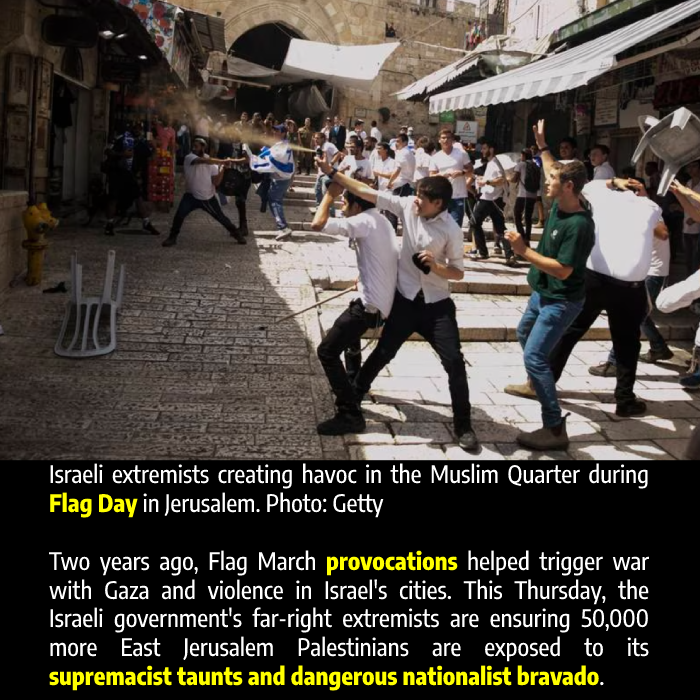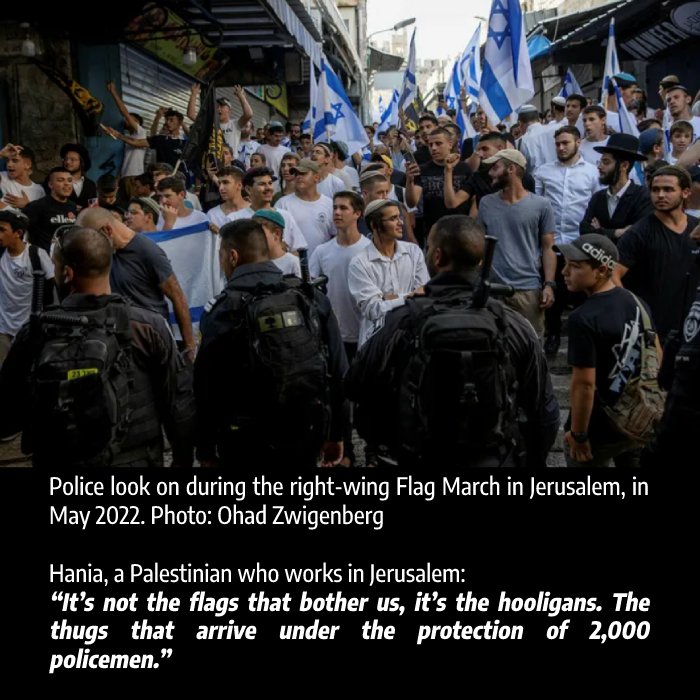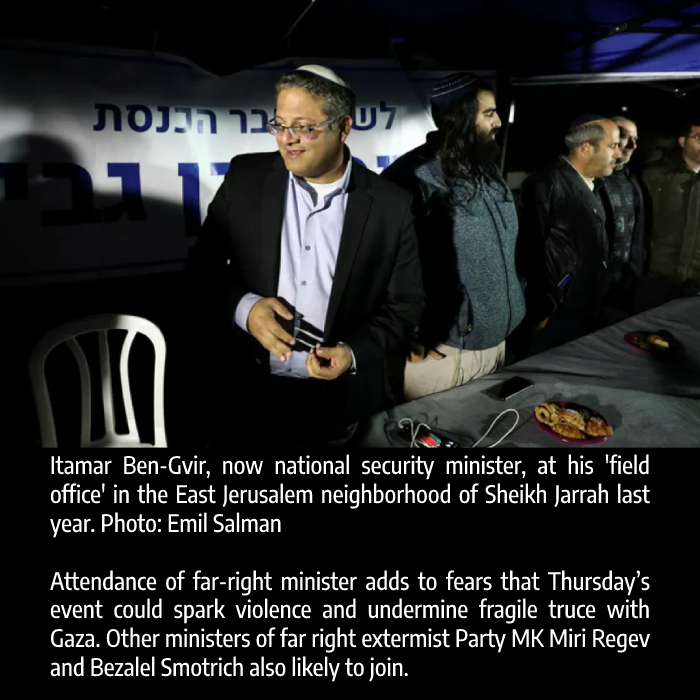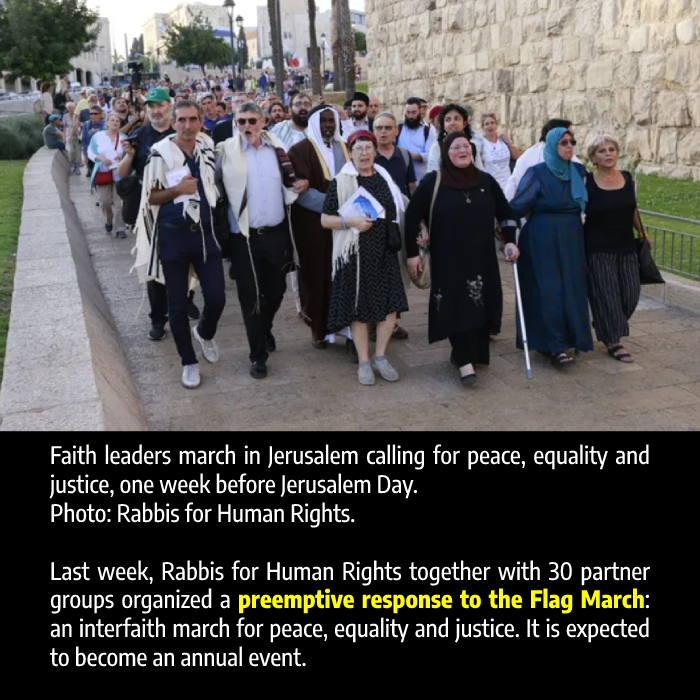By Anton Goodman.

The eyes of the country should be fixed on Jerusalem this Thursday. That’s when the pinnacle of the Jewish extremist calendar is scheduled to take place: the Jerusalem Day Flag March.
Thousands of Jewish teenage boys and young men, mostly religious Zionists, are expected to flood the alleyways of the Old City and surrounding Palestinian neighborhoods, carrying Israelis flags and, thanks to the new far-right wing of the Israeli government, a potentially dangerous new sense of entitlement.
The day will be a test for the barely days-old ceasefire with Islamic Jihad in Gaza. But with some marchers, who are already imbued with messianic fervor, seeking a way to stamp Jewish sovereignty on the Old City’s Muslim Quarter, the march has the potential to plunge us deeper into conflict.
This has always been the intention behind the parade, which puts 20,000 residents of the Muslim Quarter under curfew as the parade-goers dance through the neighborhood banging on doors and shouting chants like “Death to Arabs.” But this year, with the traditional advocates, provocateurs and organizers of the parade holding the highest national office, we can no longer relate to it as some kind of fringe event.

Indeed, now that the power lies in their hands, the parade route is being lengthened to ensure that more East Jerusalem Palestinians are exposed to its taunts and nationalist bravado.
As a member of the religious Zionist Jewish community in Israel, I have a long history with Jerusalem Day and its annual parade. In the decade that I served on the secretariat of World Bnei Akiva, the modern Orthodox youth movement, I never attended the Flag March, and instead ran discussion circles for those like me, who have become disgusted by how the day is now “celebrated” and did not want to take part. In recent years I have been a regular attendee from the sidelines – there to protest and engage with the tens of thousands of marchers.
I have watched how in the last five years in particular, the parade has succeeded in becoming a significant catalyst for conflict at the national level.
Just two years ago, in May 2021, tensions that had been roiling the city for months came to a head during the Flag March, which was the culmination of a series of provocations. Beforehand, Lehava, a Jewish-supremacist anti-miscegenation group, organized a protest of their own, which led to violent clashes that left dozens of Palestinians and police injured. Longtime far-right provocateur and politician Itamar Ben-Gvir set up his Knesset “office” in the Sheikh Jarrah neighborhood in East Jerusalem.
During the parade, Hamas fired rockets at Jerusalem, and a war broke out. This one included not just the usual cross-border rockets and bombs, but also an unprecedented level of intercommunal violence between Jewish and Arab citizens in Israel’s mixed cities.
Israel’s police chief Kobi Shabtai made no bones about whom he saw as responsible for those events, and said at the time at a briefing, “Itamar Ben-Gvir is responsible for this intifada.”
Less than two years later, Ben-Gvir has become the national security minister. Shabtai now answers to him.

Just last week, as Israelis and Palestinian civilians endured another cross-border escalation – which left dozens dead in Gaza and two dead in Israel – we saw Islamic Jihad list the cancelation of the parade as of one of their initial demands for a ceasefire.
This condition was rejected, and Prime Minister Benjamin Netanyahu promised that the parade will continue as planned along the same route. But this is not the case, since the route has been expanded – clear evidence of plans to sow provocation on an unprecedented scale.
Aryeh King, the deputy mayor of Jerusalem, a crony of Jewish extremist provocateurs-turned-ministers Ben-Gvir and Bezalel Smotrich, sounded a positively triumphant tone on Twitter to announce that the parade will for the first time continue even further into East Jerusalem.
This new, expanded route will include King’s former stomping ground of Ma’aleh Hazeitim, a settler compound of around 100 families on the Mount of Olives, next to the Palestinian neighborhood of Ras al Amud; and continue to Yeshivat Beit Orot to the north – passing through the A-Tur neighborhood.
There will also be tours and talks with Six Day War veterans in Sheikh Jarrah and other contentious neighborhoods. The implication of the extended route will be to bring the Flag March to the doors of an additional 50,000 Palestinian residents of East Jerusalem, at a conservative estimate.
Mainstream Israeli society is not preoccupied with the threat of a Jerusalem Day parade overseen by Ben-Gvir. It is still reeling from a series of destabilizing events, from the brief war with Gaza – this time with Islamic Jihad – judicial reforms and other government shenanigans. But civil society organizations in Jerusalem are well aware of it, and are focused on what could unfold on Thursday.
Several counter-demonstrations are planned, and Ir Amim, a nonprofit that promotes an equitable and stable Jerusalem, has created a coordination system for them. The Tag Meir organization, an NGO that responds to Jewish extremist violence, will hold a “flower parade” counter-event, and the nascent Faithful Left, a small group of left-wing religious Jews, is distributing flyers to synagogues in Jerusalem referring to the march as a “desecration of God’s name.”
Last week, Rabbis for Human Rights together with 30 partner groups organized a preemptive response to the Flag March: an interfaith march for peace, equality and justice. It is expected to become an annual event.
The march brought faith leaders from Islam, Judaism and Christianity together in a show of solidarity and shared vision for Jerusalem. Under police presence, marchers gathered at Zion Square, a central square in Jerusalem and a regular haunt for the far-right. It has been the scene of Netanyahu’s most inflammatory speeches against former Prime Minister Yitzhak Rabin and a place for the Lehava black-shirted youth wing of Ben-Gvir’s political party to gather and intimidate passing Arabs.

As the march left Zion Square towards the Jaffa Gate of the Old City, with faith leaders walking arm-in-arm, many onlookers came to ask questions. But for some, it was all too much. After they tried to interfere, the police had to intervene and make an arrest.
I fear most Israelis do not realize the impending threat, and are not prepared for the potential consequences of the parade. But with the sudden rise of the extreme right at the highest levels of Israel’s government, those of us in Israeli society who find this abhorrent need to urgently work towards de-radicalizing Jewish extremist discourse here.
In the case of the Jerusalem Day Flag March, there are two steps that could help.
First, the Jerusalem City Council must establish an external committee to review and approve the parade route and its planned activities, with the aim of quelling tension and preventing harm to Palestinian residents of the city.
A good comparative model would be the Northern Ireland Parades Commission, which has successfully lowered the violence and damage caused by the hundreds of politically charged sectarian parades, which still take place every summer, even in the aftermath of the peace accords there.
Second, religious and communal leaders must speak out and take a loud and public stand against the parade and what it stands for. With no representative in the government who will do this, it is the obligation of civil society and moderate religious leaders to step up and exhibit responsible leadership, one informed by human rights and Jewish discourse rooted in the values of human dignity and equality.
I fear that these current efforts will not be enough in these highly charged and incredibly volatile times. But it is a start.
There are those who believe that there is another path, one that does not involve nationalist triumphalism, incitement to violence and intimidation – one that unites, instead of dividing, Jewish and Palestinian residents of this holy city.
Anton Goodman is a religious Jewish peace activist in Israel. He is the Director of Partnerships at Rabbis for Human Rights, and serves on the board of Oz VeShalom the Orthodox Jewish Peace Movement in Israel.
Source: Haarezt. 18 May 2023